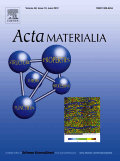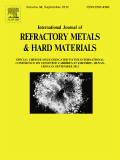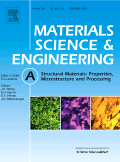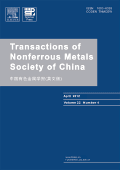
ACTA MATERIALIA
Scope & Guideline
Advancing the Frontiers of Materials Science
Introduction
Aims and Scopes
- Materials Characterization and Analysis:
The journal publishes studies involving advanced techniques for characterizing the microstructure, phase composition, and mechanical properties of materials, including both experimental and computational methods. - Mechanical Properties and Deformation Mechanisms:
Research addressing the mechanical performance of materials under various loading conditions, including studies on plastic deformation, fracture mechanics, and fatigue behavior. - Phase Transformations and Stability:
Papers discussing thermodynamic and kinetic aspects of phase transformations, including solidification, precipitation, and ordering phenomena in metallic and ceramic materials. - Nanostructured and Composite Materials:
Focus on the synthesis, properties, and applications of nanostructured materials and composites, emphasizing their unique mechanical, thermal, and electrical properties. - Advanced Manufacturing Techniques:
Research on innovative manufacturing processes such as additive manufacturing and their effects on material properties, microstructure evolution, and performance. - Interfacial Phenomena and Grain Boundary Behavior:
Studies exploring the role of interfaces and grain boundaries in determining the mechanical, thermal, and electrical properties of materials. - Machine Learning and Data-Driven Approaches:
Incorporation of machine learning techniques to predict material behavior, optimize processing parameters, and enhance material design.
Trending and Emerging
- High-Entropy Alloys (HEAs):
Research on HEAs is gaining momentum due to their exceptional properties and potential applications in various fields, including aerospace and energy. - Additive Manufacturing and 3D Printing:
There is a significant increase in studies exploring the effects of additive manufacturing on material properties, microstructure, and performance, highlighting the growing relevance of this technology. - Machine Learning and Computational Materials Science:
The integration of machine learning techniques into materials design and analysis is rapidly increasing, enabling predictive modeling and optimization of materials. - Sustainable and Green Materials:
Research focusing on environmentally friendly materials and processes is on the rise, driven by the need for sustainability in materials science. - Nanostructured Materials and Applications:
Emerging research on nanostructured materials, including their synthesis, characterization, and applications in electronics and energy storage, is becoming a prominent theme. - Electrochemical and Energy Storage Materials:
The development of advanced materials for batteries and supercapacitors is increasingly featured, reflecting the growing focus on energy storage solutions.
Declining or Waning
- Traditional Alloys and Conventional Processing Methods:
Research on classical alloy systems and conventional processing techniques, such as casting and forging, seems to be less frequent, with more emphasis on novel materials and advanced manufacturing. - Basic Thermodynamic Principles:
Papers focusing solely on fundamental thermodynamics without application to specific materials or advanced modeling approaches are becoming less common, as the field shifts towards more applied and complex systems. - Static Characterization Techniques:
There appears to be a waning interest in purely static characterization methods, with a preference for dynamic and in-situ techniques that provide real-time insights into material behavior. - Single-Phase Material Studies:
There is a noticeable decrease in the publication of studies focused solely on single-phase materials, as research increasingly emphasizes multiphase and composite systems.
Similar Journals

ACTA METALLURGICA SINICA
Leading the Charge in Mechanical and Geotechnical EngineeringACTA METALLURGICA SINICA, established in 1978 and published by SCIENCE PRESS, stands as a preeminent journal in the fields of metallurgy and materials science. This journal is particularly revered for its contributions to Metals and Alloys, Mechanical Engineering, Geotechnical Engineering, and Mechanics of Materials, with a commendable Q1 ranking in Metals and Alloys and notable placements in other engineering disciplines. With a robust history of facilitating scholarly communication from 1978 to 1991 and consistently since 1996, the journal provides a vital platform for researchers and practitioners to disseminate significant advancements in material science. Despite being a subscription-based journal, ACTA METALLURGICA SINICA remains pivotal, holding a Scopus ranking that places it in the top tiers of its categories, fostering an environment ripe for innovation and collaboration. This ensures that the journal remains central to the ongoing discussions and developments within the metallurgy community, serving both academic and professional interests.

INTERNATIONAL JOURNAL OF REFRACTORY METALS & HARD MATERIALS
Elevating the standards of refractory metals and hard materials.INTERNATIONAL JOURNAL OF REFRACTORY METALS & HARD MATERIALS, an esteemed publication by Elsevier Science Ltd, stands at the forefront of materials research, focusing on the development and application of refractory metals and hard materials in various engineering fields. With an impressive impact factor and recognition as a Q1 journal across several categories including Ceramics and Composites, Materials Chemistry, and Mechanical Engineering, it serves as a vital resource for researchers, professionals, and students alike. The journal has been continuously publishing high-quality research since its inception in 1982, with a convergence of developments spanning through to 2024. Its Scopus rankings further emphasize its significance, boasting ranks in the top percentiles of relevant scientific fields. Although it operates under a subscription model, the depth and rigor of the research published within its pages ensures that it remains an invaluable tool for those pursuing innovation and exploration in materials science.

POWDER METALLURGY AND METAL CERAMICS
Transforming Ideas into Cutting-edge Material SolutionsPOWDER METALLURGY AND METAL CERAMICS is a prestigious journal published by Springer, dedicated to advancing the field of powder metallurgy and the development of metal ceramics. With an ISSN of 1068-1302 and an E-ISSN of 1573-9066, this journal includes significant research contributions that explore innovative developments in materials science and engineering. Since its inception in 1993, it has garnered attention within multiple disciplines, consistently ranking in the Q2 and Q3 quartiles across categories such as Metals and Alloys, Ceramics and Composites, and Mechanics of Materials. The journal offers valuable insights into the synthesis, characterization, and applications of advanced materials, making it an essential platform for researchers, professionals, and students aiming to stay at the forefront of technological advancements in this dynamic field. Although not currently offering open access, the journal remains a critical resource for disseminating high-quality research that influences both academia and industry.

MATERIALS SCIENCE AND ENGINEERING A-STRUCTURAL MATERIALS PROPERTIES MICROSTRUCTURE AND PROCESSING
Bridging Theory and Application in Structural MaterialsMATERIALS SCIENCE AND ENGINEERING A-STRUCTURAL MATERIALS PROPERTIES MICROSTRUCTURE AND PROCESSING, published by ELSEVIER SCIENCE SA, is a highly regarded journal specializing in the fundamental and applied aspects of materials science. Since its inception in 1988, this journal has established itself as a leading platform for disseminating innovative research findings, particularly focused on structural materials, their properties, microstructure, and processing techniques. With a prominent impact in the field, it ranks in the Q1 category across several disciplines including Condensed Matter Physics, Materials Science, Mechanical Engineering, and Nanoscience and Nanotechnology, highlighting its significance and influence within the academic community. The journal is accessible to a global audience of researchers, professionals, and students, underscoring its commitment to advancing knowledge in materials engineering. Aspiring authors and readers will find this journal an essential resource for cutting-edge research and the latest advancements in the field, further supported by its impressive Scopus rankings that place it among the top-tier publications.

TRANSACTIONS OF NONFERROUS METALS SOCIETY OF CHINA
Connecting professionals with cutting-edge research in metallurgy.TRANSACTIONS OF NONFERROUS METALS SOCIETY OF CHINA, published by Elsevier, is a premier academic journal that serves as a vital platform for researchers and professionals specializing in materials science, condensed matter physics, geotechnical engineering, and engineering geology. Established in 1994, this esteemed publication has maintained a robust focus on the latest developments in the nonferrous metals sector, reflecting its significant impact in the field with a Q1 categorization across multiple disciplines. With impressive Scopus rankings—placing it in the top 20% of journals in relevant categories—this journal is recognized for its quality and rigor, providing critical insights into metals and alloys, materials chemistry, and their applications. The non-open access format ensures a dedicated readership among professionals and academics seeking substantial and authoritative research articles. By fostering knowledge exchange, the journal strives to advance the understanding and application of nonferrous metals, making it an essential resource for anyone involved in material innovations and engineering solutions.

TETSU TO HAGANE-JOURNAL OF THE IRON AND STEEL INSTITUTE OF JAPAN
Leading the Charge in Iron and Steel AdvancementsTETSU TO HAGANE - JOURNAL OF THE IRON AND STEEL INSTITUTE OF JAPAN is a prominent journal that publishes cutting-edge research in the fields of metallurgy, materials science, and condensed matter physics. Since its inception, this esteemed publication has served as a vital resource for professionals and researchers interested in the advancements in iron and steel technology. Published by the Iron Steel Institute of Japan, this journal has embraced an Open Access model since 2020, facilitating broad dissemination of knowledge to a global audience. The journal showcases significant contributions to materials chemistry and alloys, while consistently ranking in the Q3 and Q4 quartiles across various fields, reflecting its commitment to maintaining rigorous academic standards. Located in the heart of Tokyo, this journal not only highlights research developments in Japan but also fosters international collaboration, making it an indispensable asset for anyone engaged in the study and application of iron and steel.

Journal of Materiomics
Connecting Researchers with Cutting-Edge DevelopmentsThe Journal of Materiomics, published by Elsevier, stands at the forefront of research in the interdisciplinary fields of materials science, particularly focusing on Electronic, Optical and Magnetic Materials, Metals and Alloys, and Surface Coatings and Films. Since its inception in 2015, this Open Access journal has fostered innovative research and theoretical advancements, facilitating the dissemination of knowledge with a global audience. With an impressive impact factor and consistently ranked in the top tiers of its categories — notably Q1 in 2023 for all its major focus areas, the journal positions itself as a vital resource for researchers, professionals, and students seeking to explore cutting-edge developments in materials science. Based in Amsterdam, Netherlands, the journal encourages the rigorous investigation of material interactions at the nanoscale, fostering advancements that underscore the applicability of materials across various industries. By providing a platform for high-quality research, the Journal of Materiomics plays a critical role in shaping the future of material technologies.

Metallography Microstructure and Analysis
Exploring the Depths of Metallic MicrostructuresWelcome to Metallography Microstructure and Analysis, a prominent journal dedicated to the exploration of microstructural properties and their implications in metallic materials. Published by SpringerNature, this journal stands at the forefront of research in the field of materials science, particularly focusing on metals and alloys. With an impressive Q2 ranking in 2023 within its category and a Scopus rank of #72 out of 176, it continues to provide significant contributions to the understanding of metallography, attracting diverse readership among researchers, industry professionals, and students alike. The journal spans a converged period from 2012 to 2024, ensuring it captures the evolving landscape of metallurgical studies. Although it does not currently offer open access, this platform is essential for disseminating high-quality, peer-reviewed research that fosters innovation and development in metallurgical practices.

PHYSICS OF METALS AND METALLOGRAPHY
Decoding the Complexities of Metal Structure and BehaviorPhysics of Metals and Metallography, published by MAIK Nauka/Interperiodica/Springer, is a respected journal dedicated to the study of the physical properties of metals and their metallographic analysis, offering invaluable insights for researchers, professionals, and students in the fields of condensed matter physics and materials chemistry. With an ISSN of 0031-918X and an E-ISSN of 1555-6190, the journal has a rich history that spans from 1970 to 2024, reflecting a long-standing commitment to advancing knowledge in this vital area of materials science. Although it currently does not offer Open Access options, its strong placement in the academic landscape is underscored by its Q3 ranking in both Condensed Matter Physics and Materials Chemistry, according to 2023 metrics, and a Scopus ranking that places it within the competitive percentile of its fields. The journal is particularly important for those engaged in the cutting-edge research and technological applications of metals and alloys, making it an essential resource for anyone looking to deepen their understanding or contribute original findings to this dynamic discipline.

Korean Journal of Metals and Materials
Advancing the Frontiers of Metals and Materials ScienceWelcome to the Korean Journal of Metals and Materials, a premier publication dedicated to advancing research in the interdisciplinary fields of metals and materials science. Published by the Korean Institute of Metals and Materials, this journal aims to foster the dissemination of innovative findings and significant developments across various domains, including electronic, optical, and magnetic materials, metals and alloys, as well as modeling, simulation, and surface coatings. With a commendable Q3 quartile ranking in several relevant categories as of 2023, it serves as a vital resource for researchers, professionals, and students interested in the latest scientific trends and technological applications. The journal has successfully converged from 2007 to 2024, showcasing a rich archive of knowledge. Engaging with this publication gives readers the opportunity to stay updated with critical advancements and enhances collaboration within the vibrant materials science community. Access is available through various platforms, ensuring that our content is widely accessible to all those striving for excellence in the field.